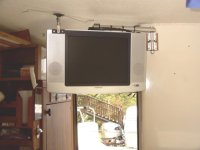We were looking for a smaller TV for the spare bedroom and thought that maybe we could get one with a DC adapter that would suit two purposes. We managed to find a 15 inch LCD flat panel TV/monitor that came with the DC adapter. Question is this-Does anyone have any suggestions for running this TV and how much power it takes to run it. We read on a thread on another site that you shouldn't plug it directly into the 12 volt cigarette socket. Presently we use a little portable DVD player but thought it would be nice to occasionly bring this TV along to watch a movie while out on the lake.
Any help would be appreciated as if we can't do this I could go a lot cheaper on the spare room TV
Rick and Donna
Any help would be appreciated as if we can't do this I could go a lot cheaper on the spare room TV
Rick and Donna


